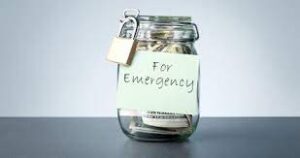In the last two years, we have seen wide ranges in our monthly spending. Two years ago, many people saw their savings increase as they stopped commuting and going out due to COVID-19. When interest rates dropped, individuals lowered their monthly housing costs by refinancing their mortgage. A year ago, people welcomed pandemic babies to their families. As companies begin returning to the office, families are adding in child care expenses or simply not returning to work. When you tack inflation onto all of this, spending habits are in different places than they were two years ago.
With these drastic differences in spending, what expenses should be part of your emergency fund? When was the last time your evaluated your emergency fund?

Living Expenses
A rule of thumb for an emergency fund is 3-6 months of expenses. If you experience job loss you may be out of work for a period of time, this will help get you through. Expenses such as mortgage or rent, utilities, insurance, gas, and groceries should be part of a basic emergency fund.
Take a deep dive into how spending has changed over the last two years. If you refinanced a mortgage, your emergency fund needs less to cover the monthly payment. If you now work remotely, you may have a low gas bill, but remember if you lose a job you may be driving around to interview for jobs. You may have adjusted to eating at home more, so your grocery expenses have gone up. If you had a child recently and are going back to work, you may want to consider having enough to cover your child being able to remain in daycare if you need to dip into your emergency fund due to a job loss.
Emergency Expenses
Along with monthly living expenses, you may want to consider having additional in your emergency fund for other costs that could arise at a moment’s notice. Being prepared for more emergencies than job loss can help should you lose a job and other emergencies come up at the same time. Examples of those expenses are insurance deductibles and unexpected home or car maintenance.
How much should you have set aside for home and car maintenance? On average people spend 1% of their home’s value on home maintenance over the course of a year. The expenses that get the most attention are replacing air conditioning units, windows, big appliances, etc. Some years, we are able to get through without anything major, so setting 1% aside in those years will provide a cushion for the years with big-ticket items. For more on this topic, see my colleague Rachel Songer’s blog post on home maintenance budgeting. Car maintenance is a little harder because it depends on what service your car could be coming up for. It may be you have an older car and just do basic fluid changes so you likely need no more than $1,000 for car maintenance. If you have a car with less than 100,000 miles on it, you should be more willing to put more money into it to keep it running. With $2,000-$3,000, there is a buffer in the event more expensive maintenance needs to occur to keep your car on the road.
Having cash set aside for your various insurance deductibles can provide peace of mind at all times. If someone gets sick, there is a car accident, or the Texas hail gets your home, do you have enough for those deductibles?
Evaluate Your Emergency Fund
How often you evaluate your emergency funds depends on how often your spending changes. If you have recently had a change to your lifestyle, reevaluate your emergency fund. As kids move from daycare to public school, debts are paid off, or if you recently moved, it’s another good opportunity to consider how much you need in an emergency fund.
Do you need more funds to cover your deductible should the need arise? Start directing savings to your emergency fund. If you received a tax refund use it to build your emergency fund. Have you lowered your expenses over the last two years and have more in the bank than you need? Invest the excess cash toward a financial goal. Or take comfort that you have a buffer and if an emergency arises you will not need to build back your emergency fund right away. Want professional help determining what your emergency fund should look like? We’re happy to help. You can reach out to us via our Contact Us page.
For more information on emergency funds, the Consumer Financial Protection Bureau has an essential guide to emergency funds.